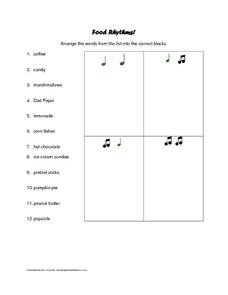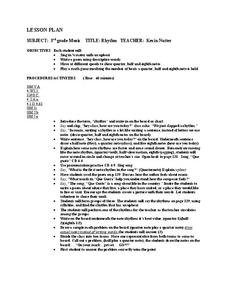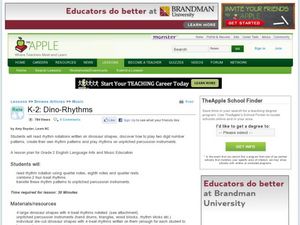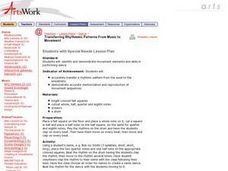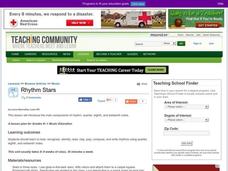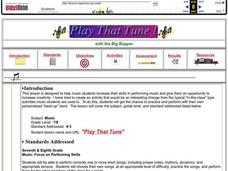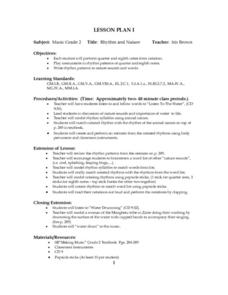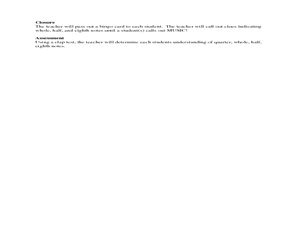Curated OER
Food Rhythms
Kids note the rhythm of 12 words and then list each word in the appropriate box on a worksheet.
Curated OER
Kindergarten Music Lesson
Singing, clapping, moving up and down with the melody, it all sounds like a great music lesson. Kinder-musicians sing three different songs to practice memory, speaking, and movement skills. They'll move to the melody, build memory with...
Education Closet
Equal Rhythms
Engage young mathematicians in learning about fractions with this cross-curricular math and music instructional activity. After listening to and repeating different beat patterns, children realize that musical notes are just another way...
Kansas Music Educators Association
Games for the Elementary Music Classroom
Perfect for music specialists, classroom teachers, and substitutes, a packet of 18 games includes complete lessons as well as short activities for when you have some extra time at the end of class.
Curated OER
Jewish Folk Song: Ya Ba Bom
Singing is a wonderful way to express an idea of any kind. This lesson is written expressly for use in directing a high school chorus. They work on using four-part harmony, expression, and melodic intervals while singing a Jewish folk...
Curated OER
Music Box Identification
Fourth graders draw and label music notes and rests. In this music box lesson students use staff paper to draw the notes required. The students give the value of each note or rest.
Curated OER
SIGHT READING RHYTHM PATTERNS
The perception of rhythms by reading and the ability to auditorily discriminate these rhythm patterns by listening to them performed by the teacher is practiced here. your students will work to create an eight-beat long rhythm pattern.
Music Fun
Time Signatures
You'll never miss a beat with a resource packet filled with puzzles, quizzes, and activity worksheets that focus on time signatures. Don't quaver or rest until you score this packet.
Curated OER
Rhythm
Third graders sing in 3/4 meter with an upbeat. They write a poem using descriptive words. Students move at different speeds to show quarter, half and eigth notes. They play a math game involving the number of beats a quarter, half and...
Curated OER
K-2: Dino-Rhythms
Second graders read rhythm notation and combine four-beat rhythms. In this rhythms lesson, 2nd graders read quarter notes, eighth notes, and quarter rests in rhythms that are written on dinosaur shapes. They clap, snap, or stamp out the...
Curated OER
You've Got Rhythm
Students study the rhythm value of a half note, quarter note, whole note, and eighth note. They stamp a rhythm pattern and create a clay animation which demonstrates note value.
North Carolina Standard Curriculum
Rhythm Counting
Understanding time signatures and rhythm counting are two very important parts of playing an instrument well. Here are three basic lessons rolled into one that prompt upper graders to play their instruments with care. They'll practice...
Curated OER
Transferring Rhythmic Patterns From Music to Movement
Students identify and demonstrate movement elements in relation to musical notation. They clap to rhythms, beat on drums, match musical notes to speech patterns and use the rhythms of the their names to create a dance.
Curated OER
Rhythm, Math, Rhythm
Students play instruments in math class to learn the interconnectedness between math and music. In this math activity, students subdivide a piece of music, clapping rhythms and charting rhythm patterns in the song. A guided discussion...
Smithsonian Institution
Spirits Across the Ocean: Yoruban and Dahomean Cultures in the Caribbean Brought by the Slave Trade
Much of Latin American music owes its origins to the slave trade. Peoples from the Yoruban and Dahomean cultures brought with them the distinctive rhythms, time signatures, and eighth note patterns that now characterize Caribbean music....
Curated OER
Reading Basic Music Notes
First graders develop skills in reading music notes. In this reading music lesson, 1st graders clap and chant rhythm patterns and learn music vocabulary. Students also match patterns by listening to the teacher perform the pattern.
Curated OER
Identifying the Beat
Sixth graders listen to various songs. In this musical properties lesson, 6th graders work in groups to identify musical selections, practice tapping the beat, review time signatures, and identify the meter of different songs.
Curated OER
Rhythm Stars
Students listen, clap, compose and identify various rhythms. In this rhythm lesson, students practice rhythm with rhythm cards. Students become familiar with stick notation. Students glue Popsicle sticks to illustrate rhythms.
Hawaiʻi State Department of Education
Rhythm Patterns
Fractions can be tricky. Why not have kids think of fractions like they think of eighth, quarter, and half notes? In teams, the class creates four-measure patterns with their percussion instruments. They need to explain their rhythm...
Curated OER
Name That Tune
Integrating technology and music can be a snap with lessons like this one! Kids in a junior high band class took to the Internet to download and practice playing their instrument with a computer generated back up band. They practice...
Curated OER
Rhythm In Motion
Sixth graders work independently and with a partner to demonstrate proficiency of steady beat, meter and basic note values while creating written rhythmic patterns for class performance. State and National Standards are addressed.
Curated OER
Music Composition
Students compose a simple melody using the notes of the D Major Scale. Criteria/Rubric for evaluation is provided with variations depending on skill level of students. A minimum of one forty-five minute class period is needed for this...
Curated OER
Rhythm and Nature
Second graders listen to song "Listen to the Water," discuss nature sounds and importance of water to life, perform quarter and eighth notes from notation, play instruments in rhythm patterns of quarter and eighth notes, and write rhythm...
Curated OER
Visualization of Rhythms in 4/4
First graders investigate musical notes. In this music lesson, 1st graders discuss the values of each note by counting the beats accordingly.


